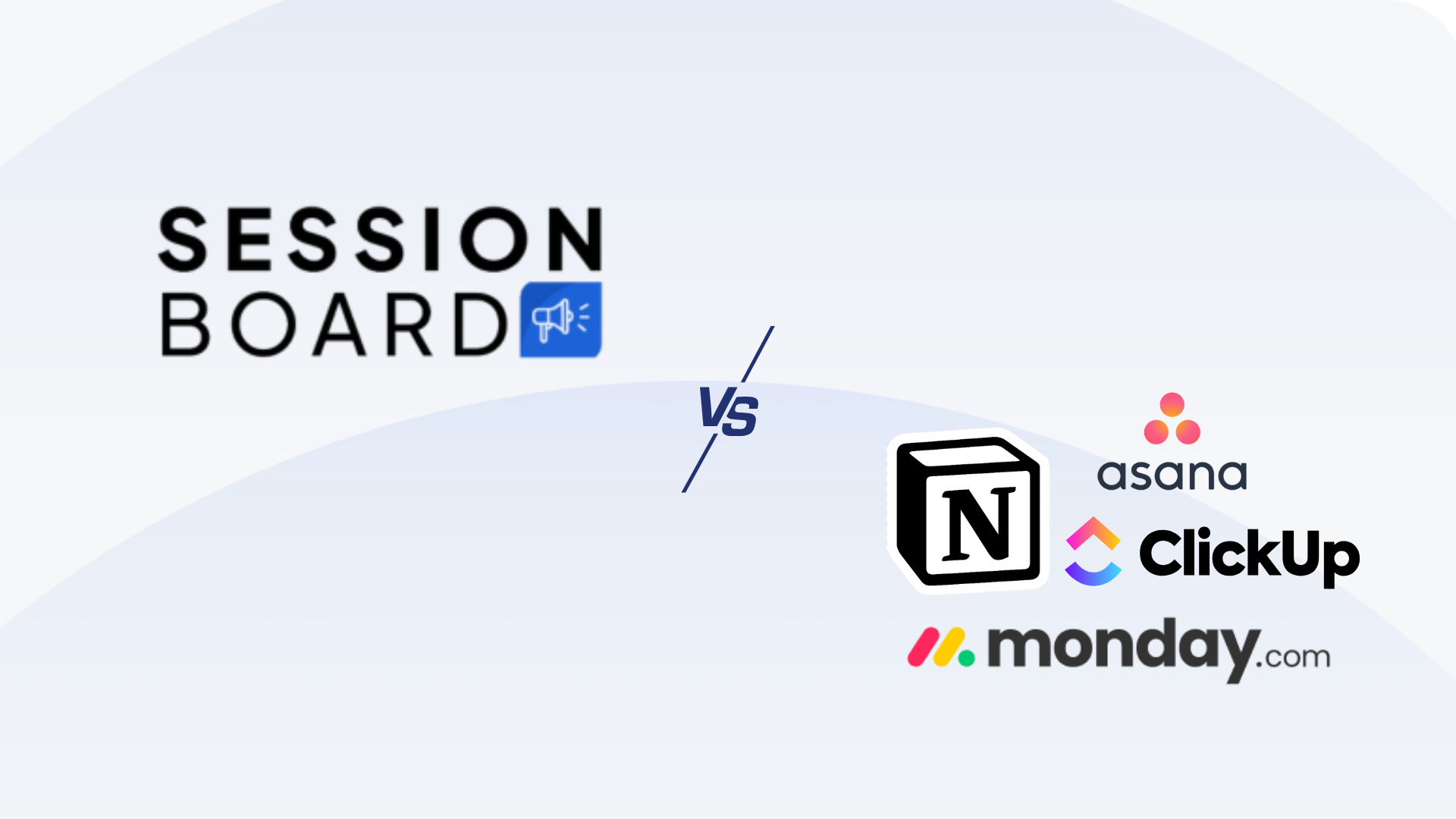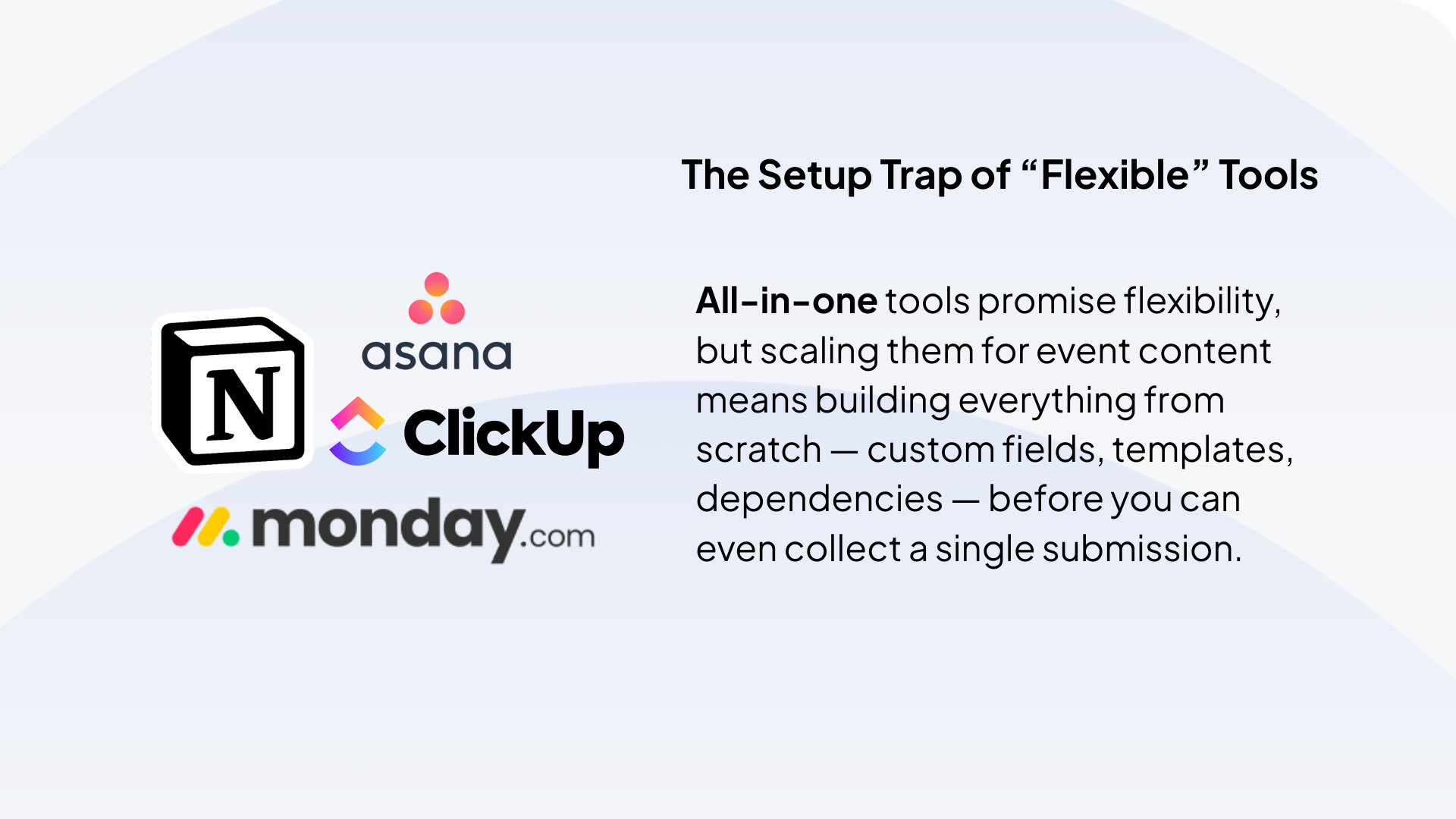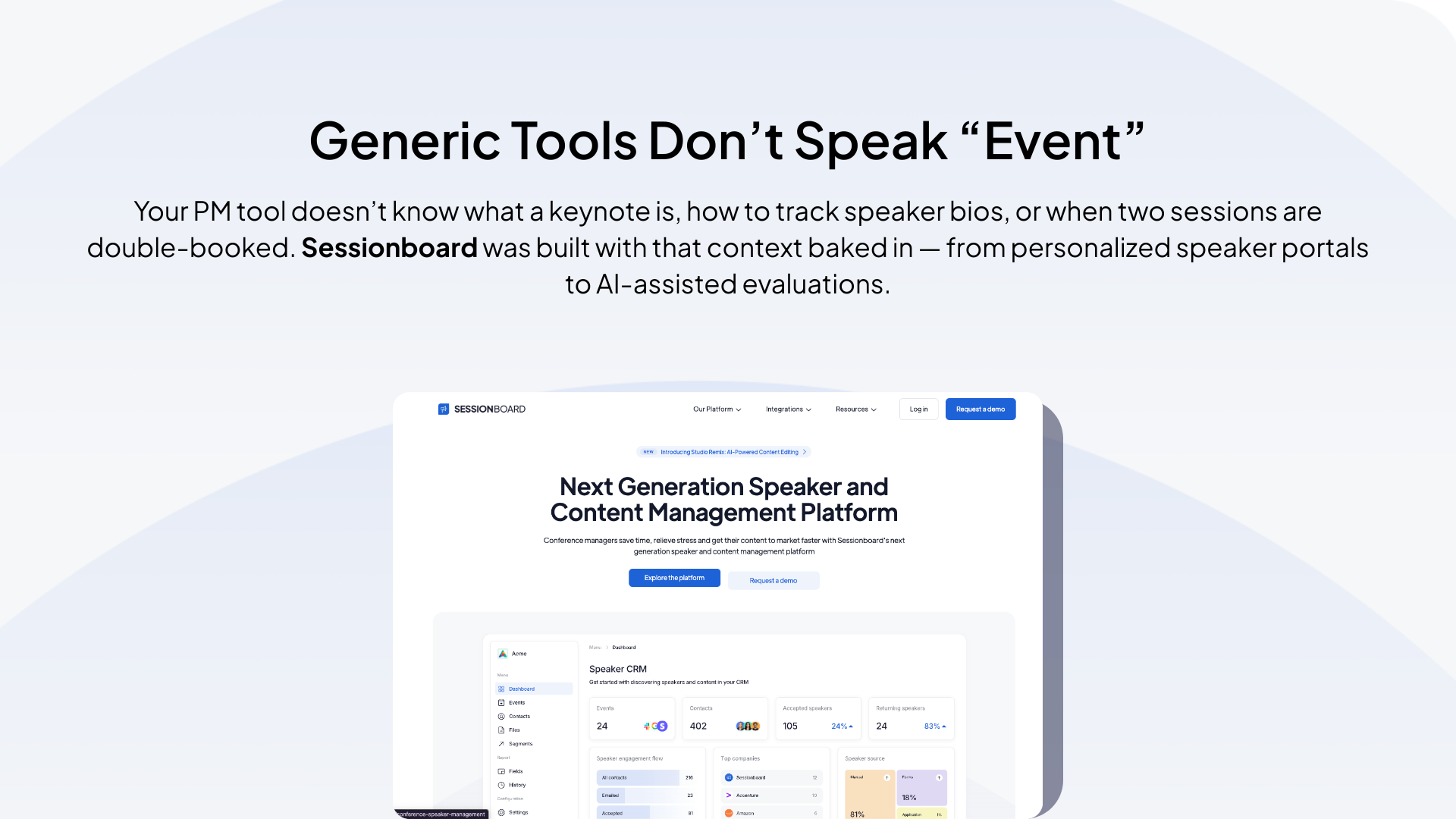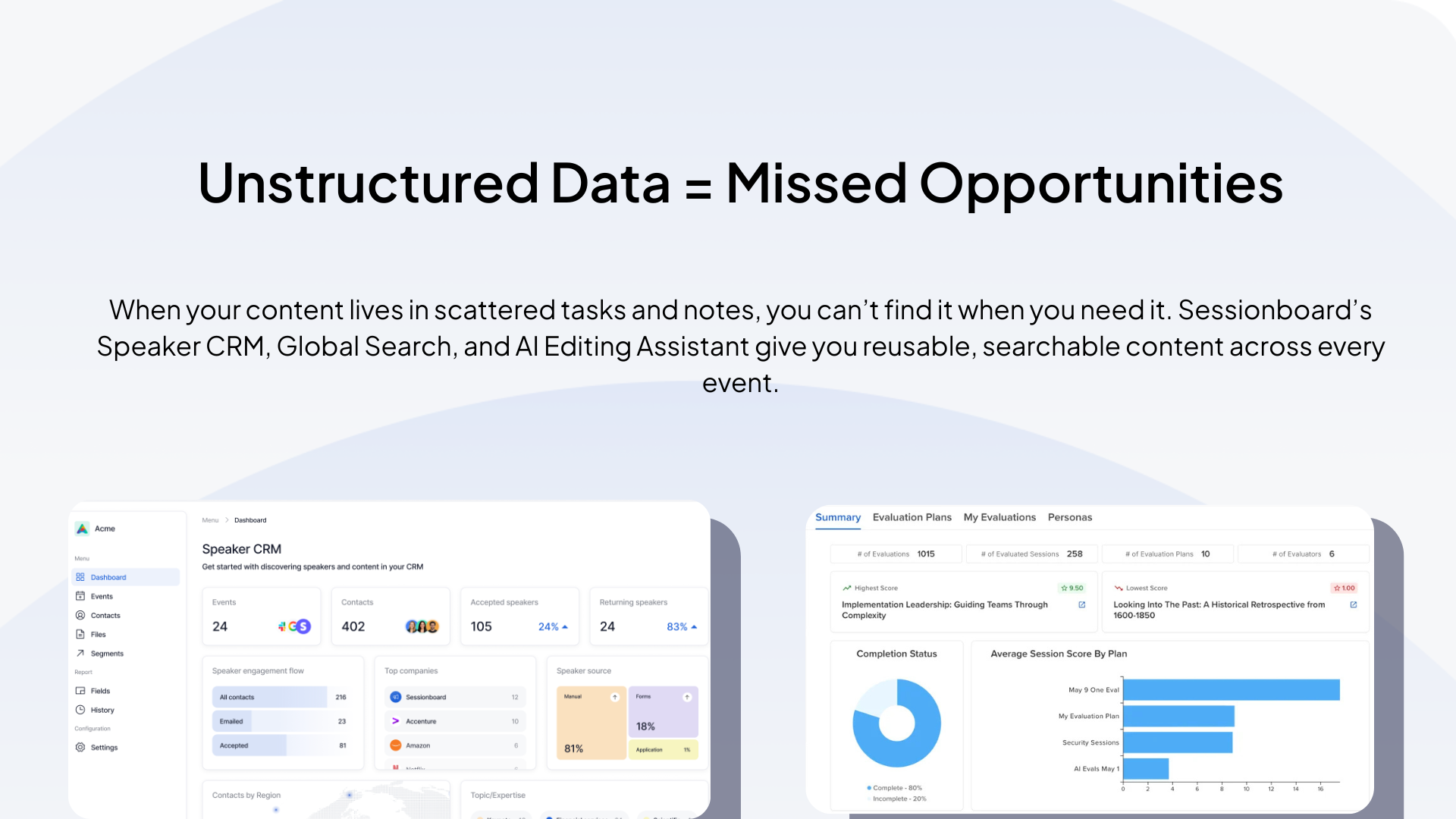Sessionboard vs. All-in-One Tools
Why Specialized Beats Generic for Event Content Management

.png)

If you’re managing event content using tools like Notion, Asana, or ClickUp, it makes sense. These platforms are everywhere. They’re flexible, collaborative, and already built into how your team works. At first, they seem like the perfect answer to organizing your speakers, sessions, and deadlines.
Until they’re not.
Because as your event grows, what looked like flexibility starts to feel like friction. You end up hacking together task lists, tagging systems, custom views, and spreadsheet embeds just to stay afloat. You’re not running a team off of one clean dashboard. You’re babysitting a patchwork of tabs, comments, and checklists that were never built for event content in the first place.
And none of that is helping you deliver a better experience for your speakers or attendees.
That’s where Sessionboard comes in. We’re not trying to replace your entire workflow. We’re giving you the piece that’s been missing — a platform built specifically for speaker and content management.
Let’s break down where all-in-one tools fall short, and why Sessionboard offers a better path forward for modern event teams.
ClickUp, Notion, and Asana are great at what they do: organize information and assign tasks. But when you’re managing 100, 300, or 700 speakers across multiple formats, that flexibility becomes a trap.
You start from scratch every time.
Custom fields. Custom templates. Custom workflows. You build your own speaker database. You create your own evaluation format. You layer on checklists and dependencies and tags. And you still end up with a system that no one else on your team fully understands. It works, technically. But only if you constantly maintain it.
Eventually, the tool that was supposed to save you time becomes just another thing to manage. And without structured data or visibility across events, you’re left trying to replicate speaker and session management with a tool that wasn’t designed for it. It starts to feel like you’re using ClickUp as a glorified spreadsheet — just prettier and harder to update.
With Sessionboard, the structure is already there.
Submission forms, review workflows, speaker portals, and agenda views are built for content-first teams. You’re not customizing from a blank slate. You’re configuring rules inside a purpose-built system. That means you spend less time wrestling with your setup, and more time building the content that drives your event.
And when it’s time to scale, you don’t need more headcount or a longer runway. You can review hundreds of submissions in minutes, assign tasks automatically, and keep everyone aligned without burning out your team. That kind of scale is hard to fake—especially with generic tools.

ClickUp doesn’t know what a keynote is. Notion doesn’t understand speaker roles or what a multi-track agenda looks like. Asana can’t flag when a speaker hasn’t submitted a bio, or when a session is scheduled in two rooms at once.
That context matters.
When you’re running a call for content, you need more than just a form. You need rubrics, reviewer tagging, multi-round workflows, and a way to evaluate sessions consistently at scale. We’ve written about what it takes to review hundreds of submissions in minutes — and why tools not built for that reality fall short.
In Sessionboard, everything is designed around real event workflows:
Instead of layering task management on top of disconnected systems, you manage everything in one unified workspace. From first draft to final session, Sessionboard gives your team the structure and tools they actually need — without the extra buildout.
And when you need to hand off work or loop in others, tools like personalized speaker portals, dashboards, and audit logs make it simple to keep everyone aligned. That’s the kind of control generic tools just can’t offer.

The biggest issue with general-purpose tools is not just missing features. It’s missing structure.
These platforms were designed to be flexible. But that flexibility falls apart when you need to scale or reuse your data across events.
Want to find every panelist who spoke about cybersecurity last year? You’ll end up sifting through scattered notes and disconnected tags.
Need to clean up 400 bios for your event website? You’re stuck with manual edits and version control nightmares.
Trying to confirm whether a new session overlaps with one from a previous event? That means hunting through emails, decks, and old spreadsheets.
This is the cost of working without structured content. You spend more time searching, fixing, and double-checking—and less time planning and improving the event experience.
Sessionboard solves this by making structure the default. Speaker bios, abstracts, topics, and tags are all captured in reusable formats. That means:
Features like Global Search, the Speaker CRM, AI Evaluators, and AI Editing Assistant are designed to work together—so you can access, improve, and reuse your content with confidence. Once you have that structure in place, your entire process gets faster, more consistent, and a lot less painful.
You’re not managing to-do lists. You’re managing sessions, formats, evaluations, and people. That requires more than generic task tools.
With Sessionboard, you get:
Everything is in one place. Everyone on your team has visibility. And speakers get a professional experience without all the back-and-forth.
It’s the same platform that helped Guru Media Hub streamline communication across dozens of speakers and Community Boost improve their speaker onboarding and visibility. When your tools are built for speaker and content workflows, your entire team works faster, communicates better, and delivers more polished events.
This is what content-first event planning looks like—less admin, more alignment, and better results.

Tools like ClickUp, Asana, and Notion are great for tracking timelines, assigning tasks, or keeping an eye on budgets. We use them too. But they’re not built for managing speaker submissions, bios, session edits, or agenda workflows.
Sessionboard doesn’t replace your project management system. It replaces the scattered documents, forms, folders, spreadsheets, and email chains that slow you down once content starts coming in. It’s the layer built specifically for everything that happens between call for papers and session delivery.
And unlike generic platforms, Sessionboard integrates directly with your event tech stack. Native connections with Cvent, ON24, Swapcard, Stova, and others ensure your speaker and session data flows automatically between systems. No more manual imports. No more version mismatches.
That means your content lives where it should—inside a system designed to support the real-world planning and publishing process for events.
So instead of bending a general-purpose tool into something it was never meant to do, you get a workspace that fits—right out of the box.
ClickUp, Asana, and Notion weren’t built for the realities of event content. Sessionboard was.
This isn’t just about replacing spreadsheets and task tools. It’s about working with a team that understands your challenges and is invested in solving them with you. Our product is shaped by the people who use it — event professionals who needed a better way to manage content at scale. And we’re proud to build alongside them.
Whether you’re managing speaker outreach, evaluating hundreds of submissions, or preparing polished content for your website, we’ll help you rethink the process with tools made specifically for the job — and the people behind them.
Want to see how it could work for your team?
[Request a demo] and let’s explore how a content-first approach can make your events smoother, faster, and more impactful.
Why Specialized Beats Generic for Event Content Management

If you’re managing event content using tools like Notion, Asana, or ClickUp, it makes sense. These platforms are everywhere. They’re flexible, collaborative, and already built into how your team works. At first, they seem like the perfect answer to organizing your speakers, sessions, and deadlines.
Until they’re not.
Because as your event grows, what looked like flexibility starts to feel like friction. You end up hacking together task lists, tagging systems, custom views, and spreadsheet embeds just to stay afloat. You’re not running a team off of one clean dashboard. You’re babysitting a patchwork of tabs, comments, and checklists that were never built for event content in the first place.
And none of that is helping you deliver a better experience for your speakers or attendees.
That’s where Sessionboard comes in. We’re not trying to replace your entire workflow. We’re giving you the piece that’s been missing — a platform built specifically for speaker and content management.
Let’s break down where all-in-one tools fall short, and why Sessionboard offers a better path forward for modern event teams.
ClickUp, Notion, and Asana are great at what they do: organize information and assign tasks. But when you’re managing 100, 300, or 700 speakers across multiple formats, that flexibility becomes a trap.
You start from scratch every time.
Custom fields. Custom templates. Custom workflows. You build your own speaker database. You create your own evaluation format. You layer on checklists and dependencies and tags. And you still end up with a system that no one else on your team fully understands. It works, technically. But only if you constantly maintain it.
Eventually, the tool that was supposed to save you time becomes just another thing to manage. And without structured data or visibility across events, you’re left trying to replicate speaker and session management with a tool that wasn’t designed for it. It starts to feel like you’re using ClickUp as a glorified spreadsheet — just prettier and harder to update.
With Sessionboard, the structure is already there.
Submission forms, review workflows, speaker portals, and agenda views are built for content-first teams. You’re not customizing from a blank slate. You’re configuring rules inside a purpose-built system. That means you spend less time wrestling with your setup, and more time building the content that drives your event.
And when it’s time to scale, you don’t need more headcount or a longer runway. You can review hundreds of submissions in minutes, assign tasks automatically, and keep everyone aligned without burning out your team. That kind of scale is hard to fake—especially with generic tools.

ClickUp doesn’t know what a keynote is. Notion doesn’t understand speaker roles or what a multi-track agenda looks like. Asana can’t flag when a speaker hasn’t submitted a bio, or when a session is scheduled in two rooms at once.
That context matters.
When you’re running a call for content, you need more than just a form. You need rubrics, reviewer tagging, multi-round workflows, and a way to evaluate sessions consistently at scale. We’ve written about what it takes to review hundreds of submissions in minutes — and why tools not built for that reality fall short.
In Sessionboard, everything is designed around real event workflows:
Instead of layering task management on top of disconnected systems, you manage everything in one unified workspace. From first draft to final session, Sessionboard gives your team the structure and tools they actually need — without the extra buildout.
And when you need to hand off work or loop in others, tools like personalized speaker portals, dashboards, and audit logs make it simple to keep everyone aligned. That’s the kind of control generic tools just can’t offer.

The biggest issue with general-purpose tools is not just missing features. It’s missing structure.
These platforms were designed to be flexible. But that flexibility falls apart when you need to scale or reuse your data across events.
Want to find every panelist who spoke about cybersecurity last year? You’ll end up sifting through scattered notes and disconnected tags.
Need to clean up 400 bios for your event website? You’re stuck with manual edits and version control nightmares.
Trying to confirm whether a new session overlaps with one from a previous event? That means hunting through emails, decks, and old spreadsheets.
This is the cost of working without structured content. You spend more time searching, fixing, and double-checking—and less time planning and improving the event experience.
Sessionboard solves this by making structure the default. Speaker bios, abstracts, topics, and tags are all captured in reusable formats. That means:
Features like Global Search, the Speaker CRM, AI Evaluators, and AI Editing Assistant are designed to work together—so you can access, improve, and reuse your content with confidence. Once you have that structure in place, your entire process gets faster, more consistent, and a lot less painful.
You’re not managing to-do lists. You’re managing sessions, formats, evaluations, and people. That requires more than generic task tools.
With Sessionboard, you get:
Everything is in one place. Everyone on your team has visibility. And speakers get a professional experience without all the back-and-forth.
It’s the same platform that helped Guru Media Hub streamline communication across dozens of speakers and Community Boost improve their speaker onboarding and visibility. When your tools are built for speaker and content workflows, your entire team works faster, communicates better, and delivers more polished events.
This is what content-first event planning looks like—less admin, more alignment, and better results.

Tools like ClickUp, Asana, and Notion are great for tracking timelines, assigning tasks, or keeping an eye on budgets. We use them too. But they’re not built for managing speaker submissions, bios, session edits, or agenda workflows.
Sessionboard doesn’t replace your project management system. It replaces the scattered documents, forms, folders, spreadsheets, and email chains that slow you down once content starts coming in. It’s the layer built specifically for everything that happens between call for papers and session delivery.
And unlike generic platforms, Sessionboard integrates directly with your event tech stack. Native connections with Cvent, ON24, Swapcard, Stova, and others ensure your speaker and session data flows automatically between systems. No more manual imports. No more version mismatches.
That means your content lives where it should—inside a system designed to support the real-world planning and publishing process for events.
So instead of bending a general-purpose tool into something it was never meant to do, you get a workspace that fits—right out of the box.
ClickUp, Asana, and Notion weren’t built for the realities of event content. Sessionboard was.
This isn’t just about replacing spreadsheets and task tools. It’s about working with a team that understands your challenges and is invested in solving them with you. Our product is shaped by the people who use it — event professionals who needed a better way to manage content at scale. And we’re proud to build alongside them.
Whether you’re managing speaker outreach, evaluating hundreds of submissions, or preparing polished content for your website, we’ll help you rethink the process with tools made specifically for the job — and the people behind them.
Want to see how it could work for your team?
[Request a demo] and let’s explore how a content-first approach can make your events smoother, faster, and more impactful.

Stay up to date with our latest news
See how real teams simplify speaker management, scale content operations, and run smoother events with Sessionboard.